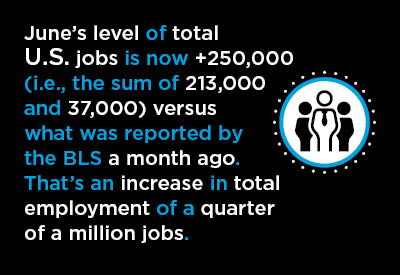June’s Employment Situation report from the Bureau of Labor Statistics (BLS) records a pickup in total jobs of +213,000 in the latest month. But that +213,000 compares June’s level of total jobs with a revised figure for May.

May’s figure is now being estimated higher by +37,000 vis à vis what was reported for May a month ago.
Therefore, June’s level of total U.S. jobs is now +250,000 (i.e., the sum of 213,000 and 37,000) versus what was reported by the BLS a month ago. That’s an increase in total employment of a quarter of a million jobs.
The gain in U.S. total employment through the first half of this year has been 1.3 million jobs. In H1 of last year, the increase was 1.1 million.
The monthly average climb so far in 2018 has been +215,000. Through the first six months of 2017, the monthly average increment was also good, but it was a somewhat lower +184,000.
Expressed another way, the monthly average jobs jump in first-half of 2018 has been +17% compared with the first-half of 2017.
The unemployment rate in June fell back slightly to 4.0% from 3.8% in May. The retreat was because the continuation of strong employment prospects has caused a month-to-month uptick in the participation rate, to 62.9% from 62.7%.
Among industrial sub-sectors, the three standouts for jobs improvement in June were: ‘education and health services’, +54,000; ‘professional and business services’, +50,000; and in a long-time-coming and pleasantly-welcome development, ‘manufacturing’, +36,000.
The leap in manufacturing employment was almost all within the durable goods realm, +32,000.
And within durable goods, hiring was most intense in ‘motor vehicles and parts’, +12,000; ‘fabricated metal products’, +7,000; and ‘computer and electronic products’, +5,000.
The +54,000 jog upwards in ‘educational and health services’ employment was comprised of ‘educational services’, +19,000; ‘health care’, +25,000; and ‘social assistance’, +10,000.
Staffing in ‘professional and business services’ (+50,000) received boosts from ‘temporary help services’, +9,000; ‘architectural and engineering services’, +7,000; and ‘computer systems design and related design’, +6,000.
‘Professional and business services’ (+28,000) is where most of the outsized revision to May’s total jobs number (+37,000) originated.
The healthy payroll expansion undertaken by architectural and engineering firms is encouraging news for contractors. More work undertaken by the project-design community will eventually lead to more on-site ‘hard hat’ activity.
As for the jobs-creation performance of the general and sub-trade contracting industry in June, however, the motion forward was a little disappointing, +13,000 jobs.
Nevertheless, the average monthly increase in U.S. construction employment through the first half of this year has been +25,000, up from +20,000 for January-to-June of 2017.
Almost half of June’s construction jobs increase (+13,000) occurred in the ‘heavy and civil engineering’ category, +6,000.
The surge in construction wages lost a little momentum in June. There are two tables focusing on compensation in the Employment Situation report, B-3 and B-8. The first, B-3, is for all workers, including supervisors. The second, B-8, is for only production workers, leaving out bosses.
From Table B-3, average hourly earnings were +2.7% year over year in June economy-wide, while average weekly earnings were +3.0%. For the construction sector on its own, the average hourly and weekly gains, as recorded in B-3, were a bit faster, at +2.9% and +3.5% respectively.
From Table B-8, there were the same hourly and weekly earnings increases across all types of work, +2.7% and +3.0%, but for construction alone, the gains were better, +3.5% hourly and +4.3% weekly.
Just the same, in five of the six months prior to June, construction workers (not including bosses) saw weekly earnings hikes of more than +4.3% year over year. (December 2017 and April 2018 crossed above +5.0%.)
‘Leisure and hospitality’ also registered a nice gain in jobs in the latest month, +25,000, led by ‘food services and drinking places’, +16,000.
‘Retail’ hiring, however, was down in the dumps, -22,000 jobs. Within ‘retail’, ‘building material and garden supply stores’ kept their payrolls flat. It was ‘general merchandise stores, including warehouse clubs and supercenters’ that initiated the big cuts, -18,000 jobs.
The bottom line is that the buoyancy in June’s U.S. labor market statistics will reaffirm the Federal Reserve’s view that the economy is doing super-well at present and that further interest rate hikes will be justified.
But there is a matter about which the Chairman of the Fed, Jerome Powell, is beginning to express concern, the threat from an escalating tariff ‘war’. On the same day as the release of June’s jobs report, the U.S. and China are imposing duties on more than $30 billion-worth of each other’s goods.
The long-in-the-tooth nature of the current boom cycle, generally rising interest rates and foreign trade conflicts are among the reasons investors have been leaving major stock market indices around the world in neutral this year.
Versus December 2017’s closing values, there have been the following end-of-June lackluster results for equity prices: the Dow Jones Industrial (DJI) average, -1.8%; S&P 500, +1.6%; London’s FTSE 100, -0.7%; the German DAX 30, -4.7%; STOXX Europe 600, -1.3%; Hong Kong Hang Seng, -3.2%; Tokyo Nikkei 225, -2.0%; and iShares MSCI emerging markets, -8.0%.
Only the Russell 2000 (composed of small- and medium-capitalization firms), +7.0%, and NASDAQ (technology firms), +8.8%, have managed to shine.











Recent Comments
comments for this post are closed